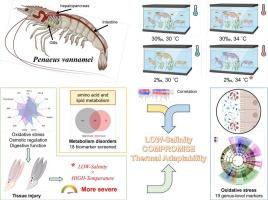The effects of thermal stress on the morphology, physiological functions, gut microbiota, and metabolism of Penaeus vannamei under seawater and low-salinity conditions
IF 3.9
1区 农林科学
Q1 FISHERIES
引用次数: 0
Abstract
Global climate change is increasing heat accumulation on the Earth's surface and raising temperatures in oceans and lakes, threatening aquatic ecosystem health. As a euryhaline species, Penaeus vannamei is temperature-sensitive, with its temperature adaptation mechanisms under varying salinities and temperature-salinity effects in complex environments remaining unclear. This study investigated the adaptability of P. vannamei to thermal stress under two salinity conditions (30 ‰ and 2 ‰). Results showed low salinity was less conducive to high-temperature adaptation, with heat stress decreasing low-salinity shrimp survival by 15.83 %. It also induced fluctuations in oxidative stress markers (SOD, MDA, ROMO1, and HSP90), osmotic regulation indicators (NKA-α, NKA-β, CLC, and CA), and digestive enzymes (AMS and chymotrypsin) under both salinity conditions. Moreover, due to temperature-salinity interaction, heat stress more readily induces physiological dysfunction and tissue damage in low-salinity shrimp, with 47 % reduced intestinal villus height. Furthermore, temperature and salinity interacted, with thermal stress more likely to cause physiological dysfunction and tissue damage in shrimp maintained at low salinity. Metabolomic analysis revealed that thermal stress induced changes in hepatopancreatic metabolic phenotypes at different salinities, with enriched differential pathways primarily related to amino acid and lipid metabolism. A total of 18 biomarker metabolites were identified. Additionally, thermal stress altered the richness, diversity, and composition of the intestinal microbiota, leading to the identification of 19 genus-level microbial markers. A correlation was observed between hepatopancreatic metabolites and intestinal microbiota composition. The study further identified a correlation between hepatopancreatic metabolites and intestinal flora composition. Our results indicate that low salinity may exacerbate high-temperature adverse effects on shrimp by impacting digestion, energy metabolism, oxidative stress, and intestinal physical-biological barriers.

海水和低盐度条件下热应激对凡纳滨对虾形态、生理功能、肠道菌群和代谢的影响
全球气候变化增加了地球表面的热量积累,提高了海洋和湖泊的温度,威胁到水生生态系统的健康。凡纳滨对虾(Penaeus vannamei)是一种温度敏感物种,其在不同盐度下的温度适应机制和复杂环境下的温度-盐度效应尚不清楚。本研究考察了凡纳梅在30‰和2‰盐度条件下对热应力的适应性。结果表明,低盐度不利于高温适应,热胁迫使低盐度对虾的成活率降低了15.83%。在两种盐度条件下,它还诱导氧化应激标志物(SOD、MDA、ROMO1和HSP90)、渗透调节指标(NKA-α、NKA-β、CLC和CA)和消化酶(AMS和糜凝胰蛋白酶)的波动。此外,由于温度-盐度的相互作用,热应激更容易引起低盐度虾的生理功能障碍和组织损伤,肠绒毛高度降低47%。此外,温度和盐度相互作用,在低盐度环境下,热应激更容易引起虾的生理功能障碍和组织损伤。代谢组学分析显示,热应激引起不同盐度下肝胰腺代谢表型的变化,主要与氨基酸和脂质代谢相关的差异通路丰富。共鉴定出18种生物标志物代谢物。此外,热应激改变了肠道微生物群的丰富度、多样性和组成,鉴定出19个属水平的微生物标记物。肝胰代谢物与肠道菌群组成之间存在相关性。该研究进一步确定了肝胰代谢物与肠道菌群组成之间的相关性。研究结果表明,低盐度可能通过影响虾的消化、能量代谢、氧化应激和肠道物理-生物屏障,加剧对虾的高温不利影响。
本文章由计算机程序翻译,如有差异,请以英文原文为准。
求助全文
约1分钟内获得全文
求助全文
来源期刊

Aquaculture
农林科学-海洋与淡水生物学
CiteScore
8.60
自引率
17.80%
发文量
1246
审稿时长
56 days
期刊介绍:
Aquaculture is an international journal for the exploration, improvement and management of all freshwater and marine food resources. It publishes novel and innovative research of world-wide interest on farming of aquatic organisms, which includes finfish, mollusks, crustaceans and aquatic plants for human consumption. Research on ornamentals is not a focus of the Journal. Aquaculture only publishes papers with a clear relevance to improving aquaculture practices or a potential application.
 求助内容:
求助内容: 应助结果提醒方式:
应助结果提醒方式:


